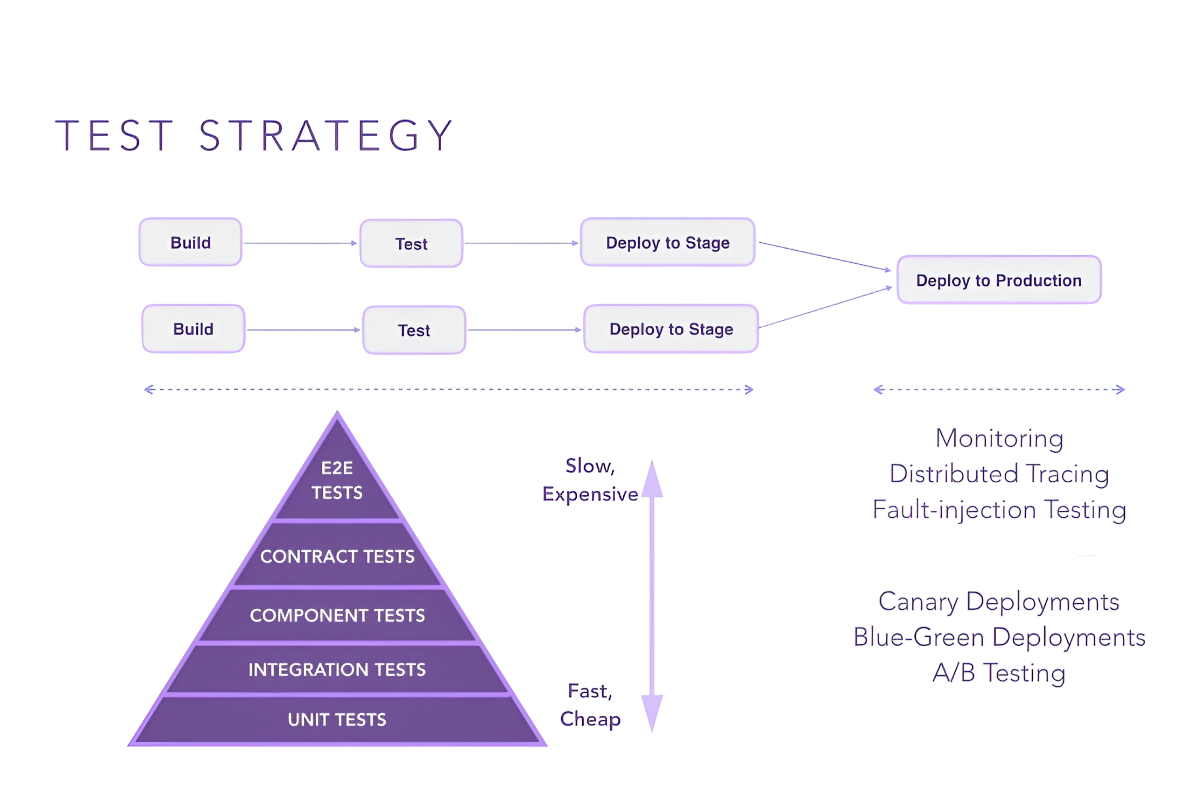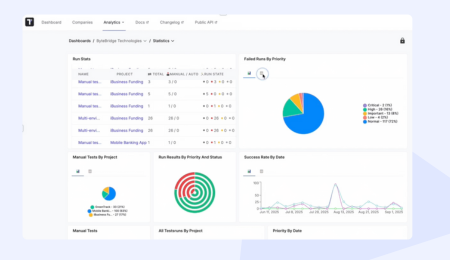Testing software is about ensuring that your software product is user friendly and bug-free. However, this is where it turns out that efficient software testing is not something that owes its success to accidental occurrences. It requires a methodical process which encompasses all the software development lifecycle.
In fact, you must have two types of documents: a map of a test strategy and a test plan. Most QA teams mix these up, which causes problems throughout the software development process. When your testing team doesn’t understand the key differences between these documents, projects get messy, deadlines get missed, and overall quality suffers.
Let’s clear this up once and for all. Understanding what each document does – and how they work together – will make your QA process much more effective. Plus, with the right test management tool like Testomat.io, you can keep everything organized and running smoothly across your entire team.
What is a Test Strategy?
A test strategy is your big-picture guide for the overall testing approach. Think of it like the blueprint for a house – it shows the overall design and method, but doesn’t get into the detailed steps of which screws to use where.

What this test strategy document is all about is how your company or your testing team goes about working with quality assurance in general. Neither is it on a certain project. What it does instead is to discuss how you intend to manage the activities of testing on all your projects in the long run. The testing strategy answers key questions like:
- What type of testing do we do? (functional testing, performance testing, security testing, etc.)
- What test management platform and tools do we use?
- How do we measure if our testing efforts are working?
- Who among team members is responsible for what?
- What are our testing standards for software quality?
What Goes in a Test Strategy Document?
Your effective test strategy should cover these key components.
| Component | Description |
| Test Objectives | Define what you aim to achieve with testing. Link these goals to business objectives and integrate them into the overall software development process. |
| Overall Testing Approach | Outline the general method for testing throughout the software development lifecycle. |
| Testing Types | Enumerate all the intended types of testing, such as functional, regression, usability/UX, performance, security and others that follow the project objectives |
| Tools & Testing Environment | Determine software and hardware testing systems such as test tools, test management, automation frameworks and other devices and configuration in the testing environment. |
| Roles & Responsibilities | Appoint roles to other members of the testing team QA engineers, developers and project managers. What do you mean by that resource allocation and ownership? |
| Risk Management | Explain how to identify, evaluate and reduce risks that can impact on software quality. Normally, institutional investors have a special contingency planning segment in their strategy or in negotiation, which have varying priorities depending on the gradually changing market conditions. |
| Entry & Exit Criteria | Establish criteria that will determine the initiation and the conclusion of testing activities. The testing progress and the benchmark on quality should be reported properly. |
Who Creates the Test Strategy?
In most of the cases, the seniors draft and keep the test strategy drafts. This would cover QA leads, test managers, or other long-term team members who are aware of the technical aspect of software testing as well as the business side of it. These folks have the experience to make good decisions about the overall testing approach for the software testing process.
The testing strategy doesn’t change very often. Once you have an effective test strategy, you might update it yearly or when there are major changes to your software development process or project requirements.
What is a Test Plan?
Now let’s talk about test plans. If the test strategy is your blueprint, the test plan is your detailed document with specific instructions. It gets specific about how you’ll test one particular project or software release.

A test plan is a detailed guide that covers exactly what you’ll test, how you’ll test it, when you’ll do the testing tasks, and who will handle test execution. Unlike the test strategy, which stays pretty stable over time, you’ll create new test plans for each specific project or major release.
The test plan takes the big ideas from your test strategy and turns them into specific, actionable testing activities.
What Goes in a Test Plan?
Your comprehensive test plan should include these details.
| Component | Purpose |
| Test Objectives for the Specific Project | Clarify the test objectives on this project and demonstrate the relationship between them to the project objectives and business objectives. |
| What You’re Testing | Give the specific functions, or modules of software that is being tested and limit the scope and test coverage |
| Testing Approach for This Project | Explain in detail how the testing will be carried out in this project and how it will match the rest of the test plan but also with more detailed tasks. |
| Testing Environment Details | Provide the particular hardware, software, network settings, and the tools that should be adopted on the tests. |
| Test Schedule | Determine the schedule of the entire testing such as the commencement and completion dates, milestones and due dates. |
| Test Case Details | Add the details on what test-cases should be executed and under which management (actual cases can be stored independently in documentation). |
| Risk Assessment for the Project | Identify project-specific risks and describe mitigation strategies for each potential issue. |
| Entry and Exit Criteria for the Project | Define the precise conditions for beginning and ending testing activities for this project. |
Who Creates the Test Plan?
Test leads, team leads and project managers usually create test plans. These are people who understand the specific project requirements and can coordinate with all the team members involved in testing activities. They ensure effective communication between different parts of the QA teams.
Since test plans are project-specific, they get updated much more frequently than test strategies. You might revise your test plan several times during a single project as project requirements change or new information comes up during the software development process.
Key Differences Between Test Strategy and Test Plan
Let’s break down the key differences between these two documents that serve different purposes in your QA process.
| Aspect | Test Strategy | Test Plan |
| Purpose | Top-level document that contains the general direction of tests and the principles that are followed by all projects. | Document project related that states how a particular release or application testing will be executed. |
| Focus | Defines what and why of testing at a strategic level. | Defines how, when, and who for a specific project. |
| Detail Level | Broad, long-term, less detailed. | Detailed, short-to-medium term, highly specific. |
| Includes | Test objectives, overall approach, testing types, tools, environment guidelines, roles, risk management, entry/exit criteria. | Project objectives, features to test, specific approach, environment details, schedule, resources, test cases, risk assessment, project entry/exit criteria. |
| Ownership | Usually prepared by test managers or senior QA leadership. | Usually prepared by QA leads or project managers. |
| Timeline | Static or rarely updated; updated only with major strategy shifts. | Dynamic; updated as the project evolves. |
| Level in Documentation Hierarchy | Sits above the Test Plan; acts as a framework for all plans. | Falls under the Test Strategy; follows its guidelines. |
How Test Strategy and Test Plan Work Together
These documents aren’t separate things that exist in isolation. They work together to create an effective testing process that supports software quality throughout the software development lifecycle.
Your test strategy provides the foundation for all testing efforts. It sets up the rules, standards, and overall testing approach that all your projects should follow. When it’s time to start a new specific project, you use your test strategy as the starting point for creating your detailed test plan.
This relationship improves the effectiveness of testing because you’re not starting from scratch with each project. Your strategy gives you a proven framework to build on. It also improves test coverage because your strategy ensures you’re thinking about all the important types of testing, not just the obvious ones.
Common Challenges and Best Practices
Many organizations struggle with keeping their test strategy and test plans effective throughout the software testing process. Here are the most common problems and how to avoid them:
Challenge 1: Mixing Up Strategy and Plan
A lot of QA teams create one document that tries to be both a strategy and a plan. This usually means they end up with something that’s either too vague to be useful as a detailed guide or too specific to work as an overall testing approach.
Solution: Keep them separate. Make sure your test strategy stays high-level and covers the overall testing approach, while your test plans get specific about testing tasks and detailed steps for each particular project.
Challenge 2: Poor Communication
Sometimes the people who write the test strategy don’t communicate well with the people who create test plans. This leads to plans that don’t align with the strategy, affecting the overall QA process.
Solution: Make sure your test management process includes regular communication between strategy and plan owners. Use a test management platform that helps everyone stay on the same page and supports effective communication.
Best Practices for Success
✅ Keep your strategy stable but flexible – Your test strategy should provide consistent guidance over time for your overall testing approach, but it shouldn’t be so rigid that you can’t adapt to new situations in the software development lifecycle.
✅ Make test plans structured and executable – Make your plans specific and actionable so that it provides the team members with specific details on when and what to do as far as testing is concerned.
✅ Apply good tools – A good test management tool such as Testomat.io will keep everything in order and ensure your strategy and plans remain related during the testing.
✅ Review regularly – Set up regular reviews for both your strategy and your plans. Strategy reviews might happen annually, while plan reviews might happen every few weeks during active projects to ensure they meet project requirements.
✅ Get everyone involved – Include all relevant stakeholders when creating and reviewing these documents. This includes developers, testers, project managers, and business representatives to ensure effective communication and alignment with business goals.
Benefits for QA Teams Using Testomat.io
Teams that use Testomat.io for test strategy and plan management typically see several improvements in their software testing process:
✅ Better organization – Everything related to the testing process is in one place, making it easier for team members to find what they need throughout the software development lifecycle.
✅ Better communications – There is less confusion that surrounds the testing projects in terms of requirements, priorities, and testing progress when all the personnel are using the same test management application.
✅ Better testing – The interdependence of the strategy, plans and execution also assists in having the testing efforts remain focused on the prioritized key test objectives and business objectives.
✅ More convenient to follow – Colleagues who join an organization and should be trained on the QA process will find it easy to follow the process when documentation and organization of the process are done on Testomat.io.
✅ Improved decision making – Managers can make better decisions when their reporting and measurements are good as they can decide on which testing should be prioritized and where resources should be directed to various projects.
Ready to Improve Your Test Management?
When your organization finds that it can no longer manage test strategies and test plans effectively for the entire process of software testing, perhaps a specialized test management tool can improve the results. Testomat.io is a platform that enables QA teams to approach their strategic, or big-picture planning as well as detailed instruction in a single platform.
With Testomat.io you may create and manage clear strategies of automated and manual tests, elaborate test plans to any particular project and make sure your daily testing efforts always contribute to the larger goals of your project. Platforms offer:
- Unified Test Management – Plan, run, and track manual and automated tests in a single, centralized platform.

- Collaboration Without Barriers – Share progress with developers, testers, and stakeholders in a format anyone can understand.
- AI-Powered Assistance – Auto-generate tests, receive improvement suggestions, and detect issues early.

- Flexible Test Execution – Target specific tests, switch environments instantly, and fine-tune execution settings.
- Unlimited Test Runs – Handle up to 100,000 tests in a single run without performance loss.
- Retrospective Change History – See what changed, when, and why with full test history tracking.

- Seamless Integrations – Works with Cypress, Playwright, Cucumber, WebdriverIO, Jest, and more.
Seamless Integrations

Ready to see how Testomat.io can help your testing team? Try the free trial and discover how much easier test management can be when you have the right test management platform supporting your process. Your QA teams and your software quality will thank you for it.
Frequently asked questions
What are the key differences between test strategy and test plan in software testing?

The key differences between test strategy and test plan serve different purposes in the software testing process. A test strategy is a high-level document that outlines your overall testing approach across the entire software development lifecycle, focusing on what type of testing to perform and why. It covers testing objectives, risk management, and best practices for your qa teams. A test plan is a detailed document for a specific project that provides detailed instructions on how, when, and who will perform testing activities. While the test strategy document rarely changes, test plans are updated frequently throughout project requirements and include specific details like test schedules, resource allocation, and entry criteria for that particular project.
How do test strategy and test plan work together to improve software quality?

Test strategy and test plan work together through a structured approach to ensure effective software testing throughout the software development process. The test strategy outlines your overall testing approach and connects testing efforts to business goals, while the test plan operationalizes this strategy for each specific project. Your effective test strategy provides the foundation covering key aspects like performance testing standards, testing environment requirements, and risk assessment procedures. The test plan then takes these guidelines and creates detailed steps for test case execution, defines the target audience for testing tasks, and establishes exit criteria. This collaboration between documents ensures test coverage aligns with project objectives and maintains consistent software quality across your entire team.
What are the essential components that should be included in an effective test strategy document?

An effective test strategy should include several key components that guide your qa process across the software development lifecycle. Essential elements include clear test objectives tied to business goals, your overall testing approach covering different types of testing (functional, performance testing, manual testing), testing environment specifications, and risk management procedures for handling potential risks. The test strategy outlines should also define roles and responsibilities for team members, specify your test management tool and testing infrastructure, establish entry and exit criteria for testing activities, and set standards for test planning and test execution. Additionally, include resource allocation guidelines, effective communication protocols for qa teams, and metrics for measuring overall quality throughout the software development process.
How often should testing teams update their test strategy and test plans?

The frequency of updates differs significantly between these documents due to their different purposes in the software testing process. Your test strategy should be reviewed annually or when there are major changes to your software development process, business goals, or testing approach. Since it provides the foundation for your overall testing efforts, the test strategy document should remain relatively stable to ensure consistency across projects. However, test plans require much more frequent updates throughout each specific project. You should review and update test plans whenever project requirements change, new potential risks are identified, testing tasks need adjustment, or test case execution reveals issues. Many testing teams update their test plans weekly or bi-weekly during active development to ensure the detailed guide remains accurate and supports effective testing throughout the project lifecycle.
What role does a test management platform like Testomat.io play in managing test strategy and test plans?

A test management platform like Testomat.io serves as a centralized solution for managing both your test strategy and test plans throughout the software development lifecycle. The platform helps maintain effective communication between team members by providing a single location where your test strategy outlines, detailed test plans, and testing activities all connect seamlessly. Testomat.io supports your qa process by linking high-level strategy goals directly to specific test cases and test execution, ensuring that daily testing tasks align with project objectives and business goals. The tool also facilitates better resource allocation, tracks progress against your test schedule, manages testing environment configurations, and provides reporting that shows how your testing efforts contribute to overall quality. This integrated approach eliminates the common problem of disconnected documents and ensures your entire team follows the same structured approach to quality assurance.








